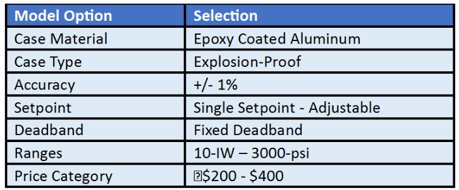
By:
Bobby Gemelas
Technical Sales Manager
Published on:
November 27th, 2023
Subscribe now and get the latest blog posts delivered straight to your inbox.
Cost of Industrial Mechanical Pressure Switches and Temperature Switches

By:
Bobby Gemelas
Technical Sales Manager
Published on:
November 27th, 2023

If you work in an industry that relies on pressure switches or temperature switches you know that these small devices play a big role in making sure your applications run smoothly and efficiently. But at what price? The short answer is between $50 - $1500. Not helpful, I know.
But, if you Google how much these instruments cost, you will be hard-pressed to find an accurate answer. The reason is simple. There are so many factors that go into the price of a switch, it’s nearly impossible to provide any kind of estimate without knowing your specific requirements.
As a product manager for industrial switches at Ashcroft – a recognized global leader in temperature and pressure instrumentation - I can help you get closer to a more precise answer. However, keep in mind, this topic covers a lot of ground. So, for the purposes of this article, we will focus on pressure and temperature switches used in industrial applications.
When you’re done reading, you will be able to validate the price range you are currently paying. You will also know what to expect if you are searching for a new supplier. Finally, you will be more prepared to make a pressure switch or temperature switch purchasing decision, whether you work with Ashcroft or not.
Why use a mechanical pressure or temperature switch?
No matter what industry you are in, you probably know that accurate and reliable pressure and temperature measurements are critical to the safety and efficiency of your process. The first step to getting a cost is to answer ‘How is the switch being used?’
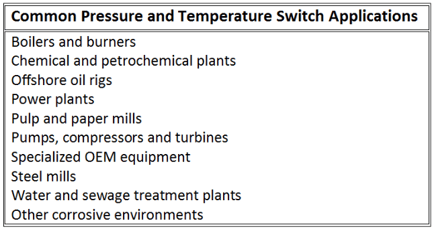
For example, OEM applications use a smaller form factor and don’t always require high accuracy or use low-cost materials such as ABS plastic that require little or no approvals. On the other hand, if the application requires higher accuracy and reliability, Hazardous Area approvals, high resistance to corrosion from ambient or process conditions, sanitary or other safety features, you can expect to pay a lot more.
The illustration below (Figure 2) shows a pressure switch that utilizes a straight-line actuator assembly to mechanically open and close a microswitch. When the pressure entering the process connection exceeds the setpoint of the switch and the force of the spring pushing down on the push rod and diaphragm, the push rod moves up and mechanically closes the button on the microswitch changing the state of the microswitch.
What are the base costs of pressure switches and temperature switches?
Mechanical pressure switches: Cost Range $50 - $1,200+
Pressure switches have two basic functions:
1. Monitor and control the amount of pressure in your system, and
2. Prevent your equipment from becoming damaged if it is not operating efficiently.
Pressure or vacuum switches will sense pressure or vacuum changes in an application. When this happens, the switch will mechanically open or close the electrical circuit at a pre-determined point to keep the system running properly and ensure equipment and personnel safety.
Figure 1. Mechanical Pressure Switch
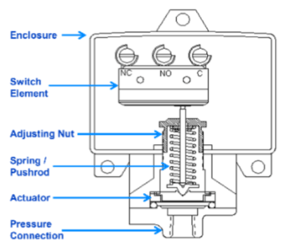
Mechanical temperature switches: Cost Range $30 - $1,500+
Similarly, temperature switches:
1. Monitor and control the temperature status of a system to prevent overheating or overcooling, and
2. Protect your equipment from becoming damaged.
Temperature switches sense changes in an application’s temperature level and mechanically open or close the switch contacts at a pre-determined point to maintain the desired temperature or to indicate an out-of-limit condition.
Both types of mechanical switches (pressure and temperature) do not require a power source and are available with additional features to address your specific application requirement. It will be your specifications and requirements that are the leading factor impacting your overall cost per item.
Figure 2: Mechanical Temperature Switch
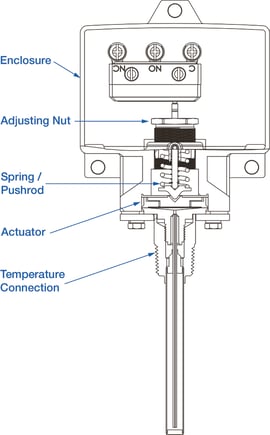
Pressure and temperature switch application specifications and requirements.
Once you go beyond the primary use of a basic model pressure or temperature switch, you need to consider the various application specifications and requirements that will likely affect the product cost. Here are a few examples:
Pressure and temperature ranges. The switch you select must be able to handle the specific pressure or temperature ranges of your application under normal operating conditions as well as spikes that may occur in the system. The higher or lower the extremes, the more likely you will need specialty materials and/or accessories to prevent those conditions from affecting your instrument’s measurements or longevity.
Pressure switch method of actuation. There are several methods of actuation for pressure switches. The three options that will affect the cost are the Bourdon tube, piston or diaphragm.
Temperature switch method of actuation. There are also different methods for sensing temperature switches. These include bellows-style actuation, a bimetallic disc or vapors (fluid) thermal system. They expand and contract to actuate the microswitch and can add to the cost.
Microswitches (pressure and temperature) method of actuation. Another cost factor is how the actuation method activates or deactivates the microswitch. For example, snap action microswitches — including straight or inline style, and cantilever designs — provide a higher rate of sensing speed. Plus, the actuation of the switch’s setpoint or reset point will typically provide greater accuracy.
Approvals. Both pressure switches and temperature switches may require certain safety or industry approvals. For example, measurement instruments used in hazardous locations must have either explosion-proof, intrinsic safety or non-incendive type approvals. While other switches may require NACE certifications and/or Safety Integrity Level certifications (commonly referred to as SIL). Whatever your specific application requires may also impact the cost of your switch.
Case materials. For applications with harsh and highly corrosive ambient conditions, you’ll likely want to employ specialized metal materials such as stainless steel or high-grade aluminum.
Process media compatibility. The switch you select must be compatible with your application. That means, the specialized wetted materials you use (i.e., process fittings, pistons, O-rings and diaphragms) to prevent corrosion issues, safety concerns and process leakage also become important cost factors.
Brass, zinc-plated materials, and epoxy-coated pressure fittings are all commonly used process fitting options for a lower-cost pressure switch alternative. However, temperature switches used with highly corrosive process media, or used in applications with high pressure may require thermowells to be added to the switch at an added cost.
Figure 3: Example of a pressure switch cost estimate.
Figure 4: Example of a temperature switch cost estimate.
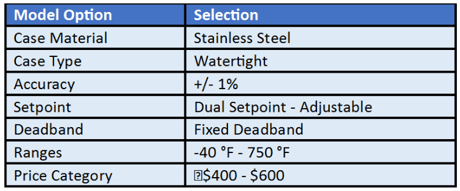
Cost is a complex challenge that we can help you address.
Now that you know many of the factors that influence the cost of pressure switches and temperature switches you can understand why it is so hard to get an exact answer to the ‘How much does it cost?’ question.
However, if you are ready to explore options that align with your specific needs, we are happy to give you a more precise cost quote. And, if you are working within a specific budget, our specialists will help you find a solution that gets you to your goal.
In the meantime, here are a few other articles that may be of interest:
- Class and Division Codes on Explosion-Proof Pressure Switches
- When Should You Use an Electronic Pressure Switch?
- Choosing a Pressure Switch: 9 Factors to Consider
- What is SIL Certification for Pressure Switches?
To learn more about the pressure and temperature instruments available at Ashcroft go to our product page where you will find datasheets, videos and other resources.
Chemical and Petrochemical industry operations are great examples of where pressure and temperature switches are used to keep systems running safely and effectively. Download our solutions guide to learn more, or contact one of our experts for direct support.
Bobby Gemelas, Technical Sales Manager
Bobby Gemelas is the Technical Sales Manager at Ashcroft. During his time with the company, he has been part of several Product Management teams, including those for industrial pressure transducers, mechanical and electronic pressure switches, digital gauges as well as temperature RTDs and thermocouples.


